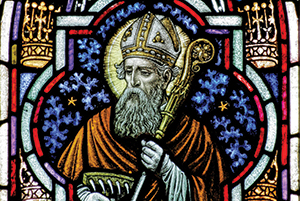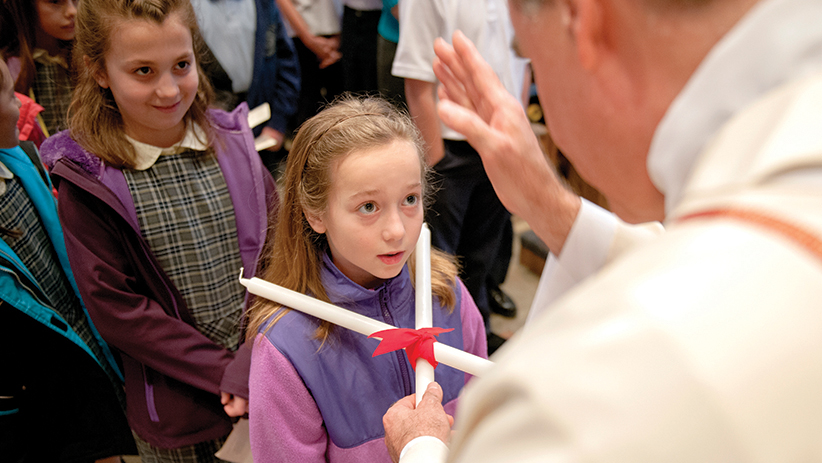Although separated by customs, language, politics and more, Catholics around the world celebrate many of the same God-inspired devotional acts, practices and rituals handed down through the centuries by Holy Mother Church. Such a devotion is the optional memorial celebrating St. Blaise and the blessing of throats every Feb. 3 in the Western Church and Feb. 11 in Eastern Church.
Facts and legends
There are few facts known about St. Blaise except that he was a fourth-century bishop in the city of Sebaste, Western Armenia, and died as a martyr. A physician, he was regarded as a righteous man and, at an early age, elected bishop by the citizens of Sebaste. Beyond those few facts, much of what we know of Blaise comes from legends. He became, during the Middle Ages, one of the most popular of all the saints and today remains highly esteemed, especially in Armenia. He is the patron saint of Dubrovnik, Croatia. His relationship with Dubrovnik is unique in that he never visited the city. In 971, he appeared in a vision to a local man warning that a Venetian force was about to invade the town. The townspeople responded with defensive measures and the Venetians, having lost the element of surprise, departed.

St. Blaise. The Crosiers
During the fourth century, the Roman Empire was separated between Emperor Constantine in the West and Emperor Licinius in the East. While frequently at odds, they came together in February 313 at Milan, Italy, to sign the Edict of Milan, intended to end all religious persecution. While this document always has been heralded as essential to Christian history, it did not end a long-simmering tension between the two emperors. Indeed, historians have recorded that Licinius was filled with greed and only signed the agreement for political purposes. There would be repeated conflicts between the East and West, mostly caused by Licinius, who was quick to continue the persecutions of Christ’s followers despite signing the Edict of Milan. In the year 316, St. Blaise would become a victim of Licinius’s hostility against Christians.
At first, Blaise avoided being arrested by escaping into the hill country near Sebaste, where he hid in a cave. His only visitors were said to be wild animals that seemed drawn to Blaise, and a special relationship allegedly developed between man and beast, similar to St. Francis centuries later. Eventually, Bishop Blaise was found out, arrested and brought before Agricolaus, the local Roman governor. He was scourged for his Christian beliefs and thrown into prison. Legend holds that either en route to prison or after he was incarcerated, two miracles attributed to Blaise occurred. A woman came to the bishop upset that a wolf had carried off her pig. Blaise offered up prayers, and the wolf returned the pig. Another incident, one for which he is most known, occurred when a mother pleaded for Blaise to cure her son who was dying from a fish bone lodged in his throat. Blaise prayed over the boy, and the child was healed.
Agricolaus soon confronted Blaise, demanding he deny Jesus or be tortured. Blaise refused, and one of the instruments of torture was an iron comb used to painfully scrape his skin. No amount of torture brought a denial of Christ, so in 316 Blaise was beheaded. The circumstance of Blaise reminds us of another holy man, St. John the Baptist, who was likewise jailed and eventually beheaded for his faith. Every three years, the Gospel read on St. Blaise’s optional memorial is from Mark 6:14-29, which tells of John’s martyrdom. Both John the Baptist and Blaise gave up their lives rather than deny Christ; Blaise was tortured and then beheaded, and John was beheaded in return for a dance.
Cult of St. Blaise
The miraculous cure of the boy suffering from the fish bone — and because Blaise had been a physician — created the belief that St. Blaise could cure most illnesses but especially those of the throat. As early as the ninth century in the Western Church, he was invoked for throat ailments, and by the 15th century, the blessing of the throat ritual had begun.
During the Middle Ages, his cult as a miraculous saint was widespread throughout Europe. He was one of the Fourteen Holy Helpers, whom Christians believed could cure a variety of personal medical problems (see sidebar). Today there are Catholic Churches all over the world bearing the name of St. Blaise.
Throat blessings
The candles used in the blessing of throats may be those blessed on Candlemas, Feb. 2, or when blessed during the St. Blaise memorial, this beautiful prayer from the Roman Ritual is provided:
“God, almighty and all-mild, by your Word alone you created the manifold things in the world, and willed that the same Word by whom all things were made take flesh in order to redeem mankind; you are great and immeasurable, awesome and praiseworthy, a wonder of marvels. Hence in professing his faith in you the glorious martyr and bishop, Blaise, did not fear any manner of torment but gladly accepted the palm of martyrdom. In virtue of which you bestowed on him, among other gifts, the power to heal all ailments of the throat. And now we implore your majesty that, overlooking our guilt and considering only his merits and intercession, it may please you to bless and sanctify and impart your grace to these candles. Let all men of faith whose necks are touched with them be healed of every malady of the throat, and being restored in health and good spirits let them return thanks to you in your holy Church, and praise your glorious name which is blessed forever; through Christ our Lord.”
Most often as part of the Mass, all parishioners desiring a blessing of their throats typically proceed to the front of the church where the priest with the two blessed candles, tied with a red ribbon, holds them in the form of an X. He touches the candles to each side of the person’s neck and says: “Through the intercession of St. Blaise, bishop and martyr, may God deliver you free from every disease of the throat, and from every other disease. In the name of the Father and of the Son and of the Holy Spirit.” The red ribbon represents the blood of martyrs, and the candles held in the shape of an “X” represent the martyrdom of another saint, St. Andrew, who according to tradition was crucified on an X-shaped cross. Not only are we freed from disease but from everything keeping us from God.
Devotions like walking the Stations of the Cross during Lent, receiving ashes on Ash Wednesday, kissing the cross on Good Friday and getting our throats blessed on St. Blaise day are essential parts of our Catholic lineage. Each ceremony or ritual excites us, elevates our hearts; we come away refreshed and with a sense that something beyond the ordinary has just happened, not just to us but to thousands of the faithful that same day in every corner of the world. We can’t help but know that it’s good to be Catholic.
D.D. Emmons writes from Pennsylvania.

